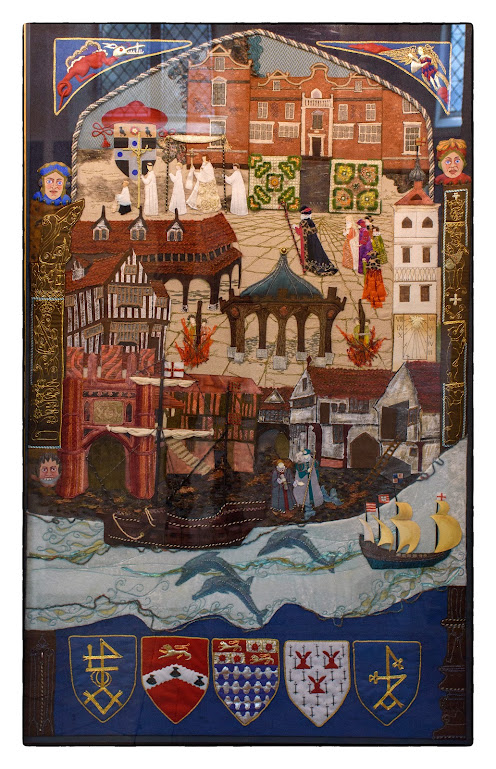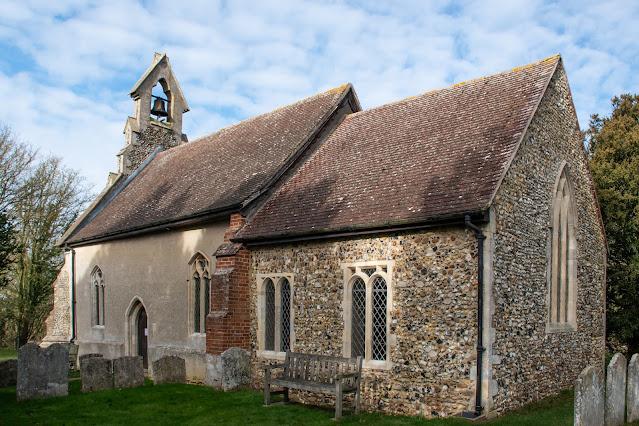Although we were going to visit Folkestone this week anyway, it was brought forward, as a tyre was needed! However, we spent time exploring, so no time lost. Folkstone is the terminal for the Eurotunnel, the rail link to Calais in France. Just 35 minutes away it says. Needless to say, we kept away from that side of the town. Although these images were not all taken the same day, they blend together quite well, starting at the Hythe end and progressing along to Folkstone. Then a short hop to Dover.
After starting our walk from Hythe, one of the first things to catch our attention were the beach huts.
I couldn't believe that there was no system in the display. I was right, as we came across a notice advertising `Creative Folkestone Artworks`. These beach huts were part of this display which covered all areas of Folkestone. If I had only known earlier!
Rana Begum - No. 1054 Arpeggio
Commissioned for Creative Folkestone Triennial 2021 in partnership with Folkestone & Hythe District Council
No. 1054 Arpeggio is the title of Rana Begum’s extraordinary colourful design that transforms around 120 beach huts on the seafront between Folkestone and Sandgate along Lower Saxon Way. The number refers to the sequence of the artist’s completed artworks, while an ‘arpeggio’ is a sequence of notes from a chord played in a rising or descending order.
Folkestone & Hythe District Council’s decision to refurbish its entire stock of beach huts presented Creative Folkestone Triennial with a challenging and idiosyncratic opportunity to commission an artist to make a major artistic statement. Rana Begum’s response to the invitation was both extremely ambitious and also generous, an astonishing blossoming of her studio practice (and its concern with geometry, colour and light) on a vast scale. Her superimposed, graduated colour scheme, and the insistent rhythm of her trademark chevron design, have turned a half-mile marching rank of beach huts into notes of colour on a keyboard, certainly one of the largest and most joyful artworks in the country.
Although No. 1054 Arpeggio is clearly an articulation of colour, it is in fact the play with light itself that is key to Rana’s work – the absorption and reflection of varied densities of light to produce an experience for the viewer that is both temporal and sensorial.She has a talent for the distillation of spatial and visual experience into ordered form, blurring the boundaries between sculpture, painting and architecture.
This I believe was part of the same work.
Pablo Bronstein - Beach Hut in the style of Nicholas Hawksmoor, 2014
Pablo Bronstein is one of the most exciting artists of his generation, combining interests in art and architecture with performance, installation and sculpture.
Bronstein has described his Beach Hut in the style of Nicholas Hawksmoor as a ‘monument to architecture’, paying homage to the quintessentially English architectural vocabulary of the 18th Century Baroque architect, Nicholas Hawksmoor. In the 18th Century the use of this heroic style was chosen deliberately for lighthouses along the south east coast because of the defensive nature of the line of ports and castles from Hastings to Dover. This architecture no longer exists in Folkestone, therefore Bronstein’s work will take the form of a lighthouse, filling a gap in the town’s history. Situated next to other brightly coloured beach huts on the waterfront, alongside the Council's mundane arrangements for park maintenance, Bronstein's sculpture's dramatic presence invokes a delightful and piquant sense of folly
Jason Wilsher-Mills - I Am Argonaut
In recent years Jason Wilsher-Mills has focused on using digital painting using technology such as iPad and Wacom tablets. The use of these technologies, in place of the more traditional artistic mediums, came about through the convenience and accessibility of tablets which allow him to produce large scale sculptures and augmented reality experiences, despite the physical challenges presented by his disability.
For Creative Folkestone Triennial 2021 the artist has drawn on his experience as a disabled artist to create a contemporary figurative sculpture (monumental in ambition but relatively intimate in size) – I Am Argonaut – to be placed ‘in conversation’ with the monumental statue of William Harvey, son of the Mayor of Folkestone, Royal Physician and discoverer of the circulation of the blood. This dialogue has a very particular and personal significance for Jason, since his disabilities have been caused by a disease of the blood in his childhood. For him it has been an opportunity to pay his respects to a great scientist whose studies paved the way for some of the great advances of modern medicine.
Major themes that consistently run throughout Jason’s work include his experience as a disabled person and the struggles he has endured through illness since childhood up until the present day, trying to translate his daily experiences and challenges to the audience. A major aspect of his work also focuses on the treatment and perception of disability and disabled people in society, as well as social history and the democratic process.
Mark Wallinger - Folk Stones, 2008
Mark Wallinger’s ‘Folk Stones’ at first appears like an almost banal numbering exercise, a “significant yet pointless act” as he puts it, recalling the labour of a modern-day Sisyphus. Yet the precise number of beach pebbles collected and laid out into a massive square reveals a profound underpinning: 19,240 individually numbered stones stand for the exact number of British soldiers killed on 1st July 1916, the first day of the Battle of the Somme.
The work is inspired by the millions of soldiers who left from Folkestone Harbour to fight on the battlefields of France and Flanders, and is located adjacent to other older war memorials. But, by using metonymy to create the idea of a crowd ‘numberless as the pebbles on a beach’, Wallinger has created a very different form of remembrance monument in which numbers replace names.
Folkestone was the main point of departure for hundreds of thousands of soldiers leaving for the battlefields of northern France during the First World War. The poet Wilfred Owen spent a night at the Metropole hotel before embarking for France, and later described its lush carpets as being as thick as the mud in the trenches. For countless other soldiers too, Folkestone must have provided some final home comforts, and its beaches and cliffs would have been the very last glimpse of England many would ever see.
This one certainly makes you think.
Before moving along the coast to Dover, another church with an interesting story in Hythe.
The church itself was open but the crypt which houses my interest had just been shut for winter. St Leonard’s Church has the largest and best-preserved collection of ancient human skulls and bones in Britain. The collection consists of shelves in four arched bays that contain 1,000 skulls in total, and a single stack of bones and skulls measuring 7.5m in length, 1.8m in width and just over 1.8m in height. The stack of bones was reassembled on its brick base in 1910. To read more about research being conducted, Click Here. (Safe - it's an internal link!)
Dover Castle commands the Strait of Dover, the shortest sea crossing between England and continental Europe, a position of strategic importance throughout history.
Castle Hill was shaped into massive defences capped by medieval walls and towers and later, from the mid 18th century, by the earthworks of a garrisoned infantry and artillery fortress. Beneath the surface, cut into the chalk of the North Downs, are networks of tunnels to enable the garrison to move, plan and live in safety.
King Henry II began to build the present castle in the 1180s, and over the next 800 years its buildings, defences and tunnels were adapted to meet the changing demands of warfare, right into the era of nuclear weapons. Its use during C20 two great wars is as follows:
THE FIRST WORLD WAR - When Britain declared war on Germany on 4 August 1914, Dover Harbour became the home of the Royal Navy’s Dover Patrol to defend the Dover Strait, particularly against German submarines, and to protect communications for the Army in France and Flanders.
Dover had a garrison of around 16,000 troops, with the castle as headquarters, to defend a perimeter occupying the high ground around the town for up to 1.5 miles distant. Within the perimeter were many training camps for soldiers destined for the Western Front.
The harbour approaches were defended by coast defence guns, while the new threat from airships and airplanes was addressed by anti-aircraft guns, including two near St Mary in Castro. Entry to the harbour was regulated and the control building, the Fire Command Post (established in 1905) and Port War Signal Station (1914), survives in Dover Castle, with a commanding view over the Channel.
THE SECOND WORLD WAR - In 1939, Dover resumed its former role when war came again, with the castle as headquarters, but for the Army garrison defending the town, and for the re-established Royal Navy base. The empty underground casemates were re-commissioned as bomb-proof offices for the vice-admiral in charge of the naval base, and as headquarters for army units co-ordinating coast artillery and anti-aircraft defences and for the units defending the Dover fortress.
These commands expanded throughout the war, as Dover became the nearest town to enemy-occupied territory in June 1940. Vice-Admiral Ramsay’s naval headquarters played a central role in Operation Dynamo, with the evacuation of 338,226 British and Allied troops from Dunkirk.
Two new levels of tunnels were built (the old ones were now called Casemate level). The first, called Annexe, was completed early in 1942 as a small hospital. The second, called Dumpy, opened in 1943 as a Combined Operations Centre with provision for large-scale communication transmission. The latter played a significant role in Operation Neptune, the naval side of the plan for D-Day, and also in a successful deception operation known as Fortitude South, which convinced the Germans that the main invasion of Europe would be in the Calais area, not Normandy, and that it would be launched from the Dover area.
The Romans built an octagonal tower-like lighthouse (pharos) on Castle Hill. This lighthouse supported fire beacons to act as navigation lights for ships approaching the narrow river mouth, enabling them to find a quayside outside the fort. I think that this is one of only two left from that period.
The pharos was later reused for the church of St Mary in Castro as a chapel and bell tower, and can still be seen in the above image.
The church of St Mary in Castro (meaning inside the castle) dates to around AD 1000. Its exceptional size hints that it might have had a royal patron – Godwin, Earl of Wessex (r.1020–53), father of King Harold (r.1066), is one possibility. A cemetery discovered during archaeological excavations in 1962 indicated that a community lived nearby.
These were the main places we visited, although a round of Crazy Golf and some shopping mustn't be forgotten. All in in all - a great week!




















































